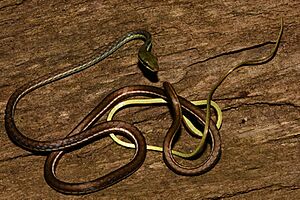Boulenger's bronzeback facts for kids
Quick facts for kids Boulenger's bronzeback |
|
|---|---|
 |
|
| Conservation status | |
| Scientific classification | |
| Genus: |
Dendrelaphis
|
| Species: |
bifrenalis
|
| Synonyms | |
|
Ahaetulla bifrenalis |
|
The Boulenger's bronzeback (scientific name: Dendrelaphis bifrenalis) is a type of snake known for its beautiful copper color. It's also called the Travancore bronze-brown snake. This snake belongs to a group called colubrids, which are generally harmless and non-venomous snakes.
You can find this snake in the Eastern Ghats of Southern India and on the island of Sri Lanka. A scientist named George Albert Boulenger first described this species in 1890.
Contents
Where Boulenger's Bronzeback Lives
This snake loves to live in trees, shrubs, and bushes. It prefers wet and in-between areas, from lowlands to mid-level hills. However, some have also been seen in drier parts of northern Sri Lanka.
These snakes are active during the day. They spend most of their time in trees, but they can also come down to the ground. When they move on the ground, they sometimes hold their head and the front part of their body upright.
What Boulenger's Bronzeback Eats
The Boulenger's bronzeback is a hunter! It mostly eats small animals like frogs, geckos, skinks, and other lizards. They are very quick and can escape easily if they feel threatened. When they get excited, they show the skin under their scales. Special scales on their belly help them climb trees.
How to Identify a Boulenger's Bronzeback
This snake has a long, thin body that is round. Its head is a bit flat and shaped like a pear, and its neck is easy to see. The front of its nose is long and rounded at the tip.
Its eyes are large with round pupils. The tail is long and can grip things, making up about one-third of the snake's total length.
Colors and Markings
The top of the snake's body is a shiny copper color. Its chin and the top of its lips are cream or light green. The tongue of this snake is red, which helps tell it apart from other similar snakes.
There's a wide black stripe on the sides of its head. This stripe goes from its eye all the way to its neck. On the front part of its body, you might see black stripes that cross diagonally. Two yellow lines run along the sides of its body, sometimes with black dots next to them. The underside of the snake is yellowish-green.
Size and Eggs
Adult Boulenger's bronzebacks usually grow to be about 70 to 90 centimeters long. They have 15 rows of scales around the middle of their body. The scales along their back are larger and stand out.
These snakes lay eggs, which means they are oviparous. They usually lay about five long eggs at a time, often in hollows found in trees.


